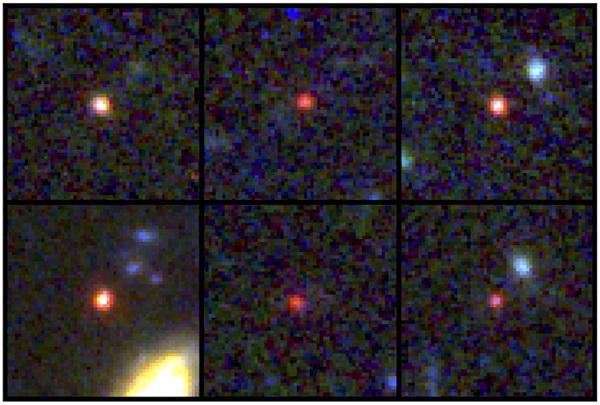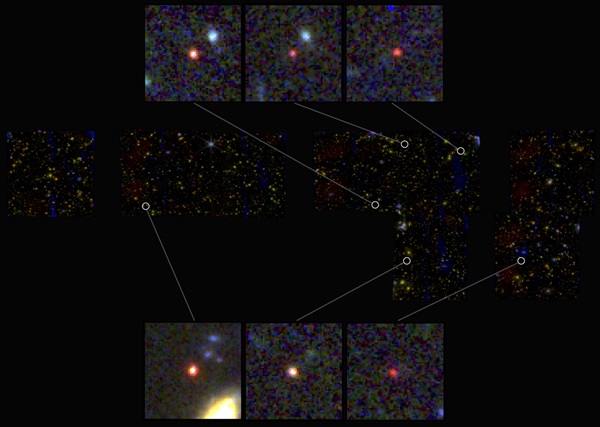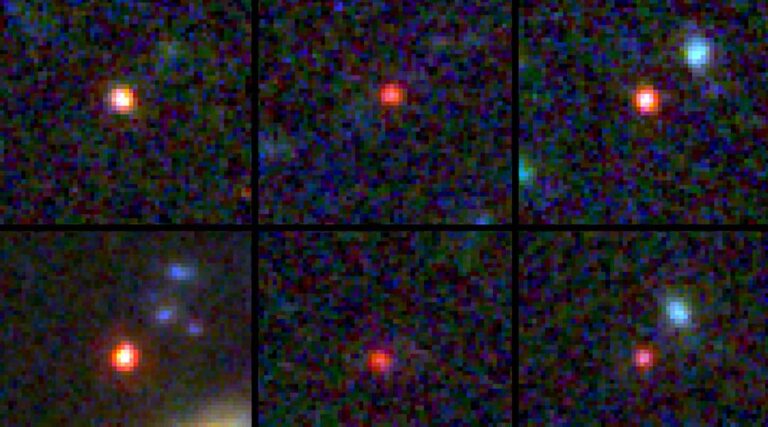“We’ve Unearthed the Unthinkable”: Massive Young Galaxies Challenge our Perception of the Early Universe.
The James Webb Space Telescope has identified substantial early galaxies, prompting scientists to reconsider the formation of the first galaxies following the Big Bang.
“Take a look at this,” exclaims Erica’s message, as she delves into the initial images captured by the recently launched James Webb Space Telescope (JWST).

NASA/ESA/CSA/I. Labbe, Author provided
It is now July 2022, merely a week since the groundbreaking images from this revolutionary super telescope were unveiled. A project spanning twenty-five years, boasting a capability surpassing previous telescopes by a factor of a hundred to a thousand, the JWST stands as one of the grandest and most ambitious scientific endeavors in human history. The temptation to express awe through superlatives is undeniable, and in this case, wholly justified.
The telescope’s construction spanned decades due to the necessity of making it foldable, facilitating its placement atop a rocket for a journey into the frigid expanse of space, situated 930,000 miles (1.5 million kilometers) away from Earth. In this remote location, far removed from Earth’s thermal interference, the JWST can discern the faintest infrared light emanating from the distant cosmos.
Unbeknownst to me, within those images lies a small red dot poised to challenge our comprehension of how the initial galaxies took shape after the Big Bang. Following months of meticulous analysis, my colleagues and I have recently published our findings in Nature.
Hunting new kinds of galaxies
Erica and I are actively engaged in the quest to unearth novel galaxy types—ones that eluded the venerable Hubble Space Telescope, despite decades of scanning the celestial expanse.
Our association dates back 15 years, originating when she was a freshman at a liberal arts college in California, and I, a newly-minted Ph.D., embarked on my initial role as a researcher in Los Angeles. During those early days, the JWST was merely a distant rumor.
Through the twists of fate, our paths intersected again many years later. Presently, Assistant Professor Erica Nelson of the University of Colorado and I find ourselves at the forefront, delving into the inaugural data from the tangible JWST.
She affectionately dubs these newfound galaxies as “UFOs” – Ultra-red Flattened Objects. I discern a broad smile between her lines, as these entities bear a striking resemblance to flying saucers. In color images, their distinct red hue stems from emitting all their light in the infrared spectrum, rendering them invisible at wavelengths perceptible to humans.
The JWST’s exceptional ability in the realm of infrared observation is its superpower, enabling the detection of the most remote galaxies. The ultraviolet and visible light emanating from the initial stars and galaxies, formed post-Big Bang, undergoes stretching due to the universe’s expansion as it travels towards us. By the time this light reaches us, it transforms into infrared light, a phenomenon uniquely unveiled by JWST.
Impossibly early, impossibly massive galaxies
All the galaxies identified by Erica exhibit a saucer-like shape, except for one. As I fixate on the minuscule red dot displayed on the screen, it becomes evident that this is no ordinary UFO. A realization dawns on me—this discovery is exceptionally distinct and holds far greater significance.
Running the analysis software on this tiny pinpoint yields two staggering figures: a distance of 13.1 billion light-years and a mass of 100 billion stars. The revelation leaves me nearly spitting out my coffee. What we have uncovered is seemingly impossible—galaxies of an astonishingly early origin and an unprecedented magnitude.
Considering the vast distance, the light from these galaxies has traversed 13 billion years to reach us. Consequently, we are witnessing these galaxies at a juncture when the universe was a mere 700 million years old, representing a mere 5 percent of its current age of 13.8 billion years. If accurate, this galaxy has managed to generate as many stars as our contemporary Milky Way but in an extraordinary timeframe.
The discovery of one such galaxy suggests the likelihood of more, and within a day, I identified an additional six.
Astronomy’s missing link?
Could we have unveiled the astronomical missing link? The realm of galaxy formation has harbored a persistent enigma. When gazing into space and retracing cosmic timelines, fully formed and mature galaxies—what we refer to as “dead galaxies”—mysteriously materialize roughly 1.5 billion years post the Big Bang.
These galaxies have ceased their star-forming activities, intriguingly captivating the attention of certain astronomers. The ages of the stars within these “dead galaxies” imply an earlier formation in the universe, yet Hubble has been unable to capture their initial, vibrant stages.
The early dead galaxies present an intriguing anomaly, harboring an equivalent number of stars as the Milky Way but compressed into a space 30 times smaller. Picture an adult weighing 220 pounds (100 kilograms) standing at a mere 2.4 inches (6 centimeters) in height. Our diminutive red dots share a similarly peculiar nature, resembling vastly reduced versions of galaxies with a standard mass.
Too many stars, too early
Nevertheless, a conundrum arises with these diminutive red dots—they exhibit an abundance of stars at an unusually early stage. Stars originate from hydrogen gas, and the foundational cosmological theory, rooted in the “Big Bang,” establishes stringent expectations regarding the quantity of gas accessible for star formation.
The rapid production of these galaxies implies a near-impossible scenario, requiring nearly 100 percent efficiency in converting all the available gas in the universe into stars. Achieving such a feat is exceptionally challenging, bordering on what scientists term as “impossible.” This revelation has the potential to revolutionize our comprehension of the formation process of the earliest galaxies in the universe.

NASA/ESA/CSA/I. Labbe, Author provided
The suggestion here is the existence of an alternative pathway, a swift route that expeditiously generates colossal galaxies with remarkable efficiency—a high-speed lane reserved for the elite top 1 percent.
In essence, each of these potential candidates could be deemed a “black swan.” The validation of just one would invalidate our prevailing model of galaxy formation, akin to the assumption that all swans are white. According to the current paradigm, all early galaxies undergo gradual and slow growth.
Checking the fingerprints
The initial step in unraveling this enigma involves validating the distances through spectroscopy, where the light from each of these galaxies undergoes prism separation, revealing its rainbow-like fingerprint. This meticulous analysis promises to provide distance measurements with an accuracy of 0.1 percent.
Furthermore, spectroscopy will unveil the source of the emitted light, discerning whether it originates from stars or perhaps something more exotic.
Interestingly, approximately a month ago, JWST fortuitously targeted one of the six massive galaxy candidates, revealing it to be a distant baby quasar. A quasar is an extraordinary phenomenon arising when gas descends into a supermassive black hole at a galaxy’s core, resulting in a luminous emission.
This revelation is particularly thrilling as the genesis of supermassive black holes in galaxies remains an unsolved puzzle, and the identification of baby quasars might hold pivotal answers. However, the challenge lies in the fact that quasars can outshine their entire host galaxy, making it challenging to ascertain the galaxy’s actual mass and the number of stars within.
Could this be the explanation for all of them? The prevalence of baby quasars? While it seems improbable, further investigation is required over the next year to explore the remaining galaxies and provide conclusive answers.
With one black swan elucidated, the quest continues with five more awaiting scrutiny.
This article is republished from AstronomyCom under a Creative Commons license. Read the original article.
Do not forget to share your opinion with us to provide you with the best posts !




0 Comments